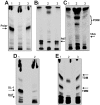Mycobacterium tuberculosis WhiB3 maintains redox homeostasis by regulating virulence lipid anabolism to modulate macrophage response
- PMID: 19680450
- PMCID: PMC2718811
- DOI: 10.1371/journal.ppat.1000545
Mycobacterium tuberculosis WhiB3 maintains redox homeostasis by regulating virulence lipid anabolism to modulate macrophage response
Abstract
The metabolic events associated with maintaining redox homeostasis in Mycobacterium tuberculosis (Mtb) during infection are poorly understood. Here, we discovered a novel redox switching mechanism by which Mtb WhiB3 under defined oxidizing and reducing conditions differentially modulates the assimilation of propionate into the complex virulence polyketides polyacyltrehaloses (PAT), sulfolipids (SL-1), phthiocerol dimycocerosates (PDIM), and the storage lipid triacylglycerol (TAG) that is under control of the DosR/S/T dormancy system. We developed an in vivo radio-labeling technique and demonstrated for the first time the lipid profile changes of Mtb residing in macrophages, and identified WhiB3 as a physiological regulator of virulence lipid anabolism. Importantly, MtbDeltawhiB3 shows enhanced growth on medium containing toxic levels of propionate, thereby implicating WhiB3 in detoxifying excess propionate. Strikingly, the accumulation of reducing equivalents in MtbDeltawhiB3 isolated from macrophages suggests that WhiB3 maintains intracellular redox homeostasis upon infection, and that intrabacterial lipid anabolism functions as a reductant sink. MtbDeltawhiB3 infected macrophages produce higher levels of pro- and anti-inflammatory cytokines, indicating that WhiB3-mediated regulation of lipids is required for controlling the innate immune response. Lastly, WhiB3 binds to pks2 and pks3 promoter DNA independent of the presence or redox state of its [4Fe-4S] cluster. Interestingly, reduction of the apo-WhiB3 Cys thiols abolished DNA binding, whereas oxidation stimulated DNA binding. These results confirmed that WhiB3 DNA binding is reversibly regulated by a thiol-disulfide redox switch. These results introduce a new paradigmatic mechanism that describes how WhiB3 facilitates metabolic switching to fatty acids by regulating Mtb lipid anabolism in response to oxido-reductive stress associated with infection, for maintaining redox balance. The link between the WhiB3 virulence pathway and DosR/S/T signaling pathway conceptually advances our understanding of the metabolic adaptation and redox-based signaling events exploited by Mtb to maintain long-term persistence.
Conflict of interest statement
The authors have declared that no competing interests exist.
Figures












Similar articles
-
Mycobacterium tuberculosis WhiB3 Responds to Vacuolar pH-induced Changes in Mycothiol Redox Potential to Modulate Phagosomal Maturation and Virulence.J Biol Chem. 2016 Feb 5;291(6):2888-903. doi: 10.1074/jbc.M115.684597. Epub 2015 Dec 4. J Biol Chem. 2016. PMID: 26637353 Free PMC article.
-
Mycobacterium tuberculosis arrests host cycle at the G1/S transition to establish long term infection.PLoS Pathog. 2017 May 22;13(5):e1006389. doi: 10.1371/journal.ppat.1006389. eCollection 2017 May. PLoS Pathog. 2017. PMID: 28542477 Free PMC article.
-
Mycobacterium tuberculosis WhiB3: a novel iron-sulfur cluster protein that regulates redox homeostasis and virulence.Antioxid Redox Signal. 2012 Apr 1;16(7):687-97. doi: 10.1089/ars.2011.4341. Antioxid Redox Signal. 2012. PMID: 22010944 Free PMC article. Review.
-
Mycobacterium tuberculosis WhiB3 maintains redox homeostasis and survival in response to reactive oxygen and nitrogen species.Free Radic Biol Med. 2019 Feb 1;131:50-58. doi: 10.1016/j.freeradbiomed.2018.11.032. Epub 2018 Nov 27. Free Radic Biol Med. 2019. PMID: 30500421 Free PMC article.
-
Redox biology of tuberculosis pathogenesis.Adv Microb Physiol. 2012;60:263-324. doi: 10.1016/B978-0-12-398264-3.00004-8. Adv Microb Physiol. 2012. PMID: 22633061 Review.
Cited by
-
Applications of Transcriptomics and Proteomics for Understanding Dormancy and Resuscitation in Mycobacterium tuberculosis.Front Microbiol. 2021 Mar 31;12:642487. doi: 10.3389/fmicb.2021.642487. eCollection 2021. Front Microbiol. 2021. PMID: 33868200 Free PMC article. Review.
-
Lsr2, a pleiotropic regulator at the core of the infectious strategy of Mycobacterium abscessus.Microbiol Spectr. 2024 Mar 5;12(3):e0352823. doi: 10.1128/spectrum.03528-23. Epub 2024 Feb 14. Microbiol Spectr. 2024. PMID: 38353553 Free PMC article.
-
Mycobacterium tuberculosis Transcription Factor EmbR Regulates the Expression of Key Virulence Factors That Aid in Ex Vivo and In Vivo Survival.mBio. 2022 Jun 28;13(3):e0383621. doi: 10.1128/mbio.03836-21. Epub 2022 Apr 26. mBio. 2022. PMID: 35471080 Free PMC article.
-
Iron Supplementation Therapy, A Friend and Foe of Mycobacterial Infections?Pharmaceuticals (Basel). 2019 May 17;12(2):75. doi: 10.3390/ph12020075. Pharmaceuticals (Basel). 2019. PMID: 31108902 Free PMC article. Review.
-
Mycobacterium tuberculosis Central Metabolism Is Key Regulator of Macrophage Pyroptosis and Host Immunity.Pathogens. 2023 Aug 30;12(9):1109. doi: 10.3390/pathogens12091109. Pathogens. 2023. PMID: 37764917 Free PMC article.
References
-
- Dye C, Scheele S, Dolin P, Pathania V, Raviglione MC, et al. Global Burden of Tuberculosis: Estimated Incidence, Prevalence, and Mortality by Country. JAMA. 1999;282:677–686. - PubMed
-
- Reed MB, Domenech P, Manca C, Su H, Barczak AK, et al. A glycolipid of hypervirulent tuberculosis strains that inhibits the innate immune response. Nature. 2004;431:84–87. - PubMed
-
- Camacho LR, Constant P, Raynaud C, Laneelle MA, Triccas JA, et al. Analysis of the phthiocerol dimycocerosate locus of Mycobacterium tuberculosis. Evidence that this lipid is involved in the cell wall permeability barrier. J Biol Chem. 2001;276:19845–19854. - PubMed
Publication types
MeSH terms
Substances
Grants and funding
LinkOut - more resources
Full Text Sources
Medical
Molecular Biology Databases
Miscellaneous

